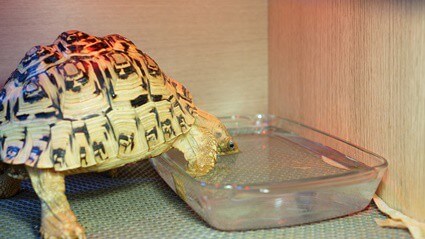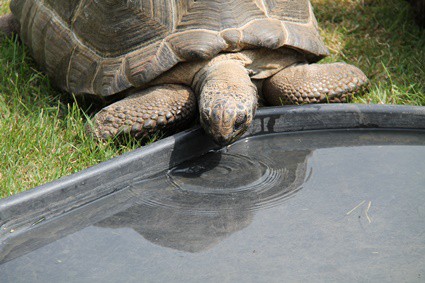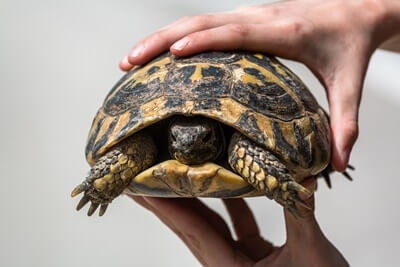Last Updated on September 19, 2023 by Samantha Harris
According to the Movement Ecology Journal, tortoises can withstand hot and arid environments. While it’s not ideal for tortoises to go without water for long periods, sometimes they have no option.
A tortoise can go without drinking water for up to 1 week in a low-humidity environment. Anything over 2 days can adversely affect tortoises because they should drink water daily.
Dehydration has life-threatening consequences for tortoises. The symptoms of dehydration include sunken eyes, lethargy, weight loss, poor muscle tone, and cracked skin.
Dehydration can lead to problems such as:
- Chemical imbalances.
- Bladder stones.
- Skeletal and shell concerns.
- Constipation.
- Impaction.
If a tortoise eats its meals, it may avoid drinking water because it’s sufficiently hydrated from its meals. This is most likely if you feed a tortoise water-rich foods like watermelon and cucumber.
Signs of A Dehydrated Tortoise
You may have never seen your tortoise drink because tortoises often glean water from food and soak in it.
If you notice one or more of these symptoms, your tortoise could be dehydrated:
Closed or Sunken Eyes
Sunken or closed eyes are the most obvious signs of dehydration. A severely dehydrated tortoise may even develop dimpled corneas.
This symptom further complicates hydration, as your pet tortoise might not forage for water or soak in its water bowl voluntarily since it feels ill.
If your tortoise has closed or sunken eyes, it needs immediate hydration and could require follow-up care to treat damage to its eyes or vital organs.

Reduced Body Weight
A significant part of a healthy tortoise’s body mass is the water in its tissues. A dehydrated tortoise lacks water and will feel light when you lift and hold it.
Note if your tortoise appears to have lost weight. This may not be physically obvious, but it’ll be notable when you pick it up. Weight loss is dangerous for smaller tortoises once it’s progressed this far.
You can identify dehydration early by weighing the tortoise on a scale.
Poor Muscle Tone
Dehydration causes loss of strength, fatigue, and poor muscle tone.
You can test your tortoise’s muscle tone by gently pulling its leg. Most tortoises will withdraw their legs quickly into their shell. If your tortoise doesn’t withdraw its legs or does so sluggishly, it’s a warning sign.
Lethargy
If you notice your tortoise isn’t moving around, exploring, or foraging for long periods, this is a red flag. Tortoises that rest for abnormally long periods and seem lethargic may be dehydrated.
Wrinkled and Dry Skin
Although tortoises’ skin is tough, it should rest smoothly against their muscles (except in creased areas, like the inside of the elbow). To test this out, gently pinch the skin of your tortoise.
Your tortoise is likely dehydrated if the skin doesn’t move back into place or moves slowly. A dehydrated tortoise’s skin will also be more puckered, dry, and wrinkled than usual.
How To Treat A Dehydrated Tortoise
Depending on how dehydrated your tortoise is, you may be able to rehydrate it at home. With some environmental changes, you can help it recover within days. Here’s how:
1/ Increased Humidity
The humidity level in your tortoise’s enclosure is wrong, leading to dehydration. You can assist a tortoise with a low thirst drive to absorb more water by increasing the amount of humidity.
Buy a humidity gauge for the enclosure. Mist your tortoise’s enclosure to increase the moisture content in the air, and close the tank lid to maintain the humidity.
2/ Moisture-Rich Foods
Your tortoise’s food should be misted for added hydration.
Fruits and greens with a high water content are ideal, such as lettuce, cucumber, and watermelon. As tortoises get more water from their food than from drinking, this will assist with rehydration.
3/ Electrolyte Solution
Electrolyte solutions regulate and control the balance of fluids in the body. To make the electrolyte solution for a tortoise, you’ll need the following:
- 1 part iodized table salt (containing sodium chloride and iodine only).
- 1 part of potassium salt (potassium chloride).
- 1 part baking soda (sodium bicarbonate).
- 12 parts sugar, but don’t use a sugar substitute like stevia.
Add fruits and vegetables to the electrolyte solution to make it more palatable.
You’ll have an electrolyte powder once you mix all the ingredients. Now, you can dissolve this powder in water before you give it to your tortoise.
Once you mix this solution with water, it has a shelf-life. You shouldn’t keep it in the refrigerator for more than 24 hours, or bacteria and mold will begin to grow.
Mix the electrolyte powder with water in the following ratios:
- 1 cup of water with 1 heaped tablespoon of the electrolyte powder.
- 1 liter of water with 2.5 heaped tablespoons of the electrolyte powder.
- 1 gallon of water with 2/3rds of a cup of the electrolyte powder.
4/ Warm Water Soak
Tortoises drink water and absorb water through the skin around the cloaca while soaking.
According to the Journal of Fish and Wildlife Management, tortoises use the skin around the cloaca in their tails to absorb water, hence why soaking increases hydration levels.
Tortoises need frequent soaks to prevent their skin and shell from cracking due to dryness. Without enough water in the air, their skin and scales will dry out.
Tortoises like to drink water from their bathing container while you’re giving them a soak. Consider soaking them in an electrolyte solution to increase their fluid and hydration levels.
How To Soak A Tortoise
Most tortoises are cooperative during baths. Here are the steps for soaking a tortoise:
Fill The Container
Ensure your tortoise’s bathing area is large enough to move around comfortably.
Use lukewarm water for the soak. If the temperature is too hot, add cold water or wait for it to cool down before introducing your tortoise. Hot water will dry out or burn the tortoise’s skin.
Likewise, cold water can make your tortoise lethargic and unsettle its digestion. Tortoises are ectothermic, so they rely on their environment to gain warmth.

Soak
Introduce your tortoise to the container once the water reaches the optimum temperature.
Ensure the water level isn’t above the tortoise’s jaw level. Tortoises can’t swim or tread water, so filling the container too full can result in drowning.
Allow your tortoise to enjoy the water as its body rehydrates naturally.
Most tortoises poop while soaking in warm water. If this happens, empty and replace the water, as this will prevent the tortoise from getting infected due to the dirty water inside the container.
Rehydration
Allow 10-20 minutes for the tortoise to rehydrate in its soaking tub.
It’ll need some time to soak to rehydrate effectively. You’ll know your tortoise is ready because it’ll try to climb out of the bath.
Lift the tortoise gently and lift it from the container once it’s done.
Drying Off
Never return a tortoise to its enclosure while still wet, no matter how much hydration is needed. This will cause your tortoise to grow cold or damp, inviting illnesses and respiratory infections.
Take a towel and pat down all the edges of the shell and around the tops of its head, neck, and legs.
Water Disposal
Never reuse the same water on your newly soaked pet or any other animal.
Reptiles carry salmonella on their skin, which can cause bacterial infections in humans. So, never pour bathwater down the kitchen sink, or anywhere you would wash your face.
Pour the dirty bathwater into a drain or down the toilet.





